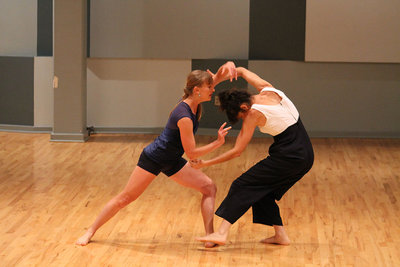
On a hot, sticky summer day, three dancers move with all their might through intricate and instinctual movement exploring relationships and memory. The piece they’re working on is for an informal performance the following night, but the work they’re doing, the act of creating, is for something much bigger. They’re building community, one move at a time.
Traveling through dynamic shifts in weight and balance, the dancers are preparing the piece, “Breathing Under Water,” for a Dance in Dialogue (D.i.D) showing the next night — an intimate, salon-like environment that invites inquiry into the movement art form by simply asking the audience to say what they see.
“At its essence, D.i.D creates a venue where artists can create more work to show and share and talk about it,” says co-founder Margo Van Ummersen. “It’s a safe space to take risks. It’s low stress, process-oriented. There’s no tech. You can present raw work, an idea.”
D.i.D, a quarterly dance series, combines the appeal of low-pressure creativity with the opportunity to have that effort witnessed by an audience.
“If I start a work and know I have to have a finished piece, it changes things,” Van Ummersen says. “For D.i.D, it doesn’t have to be perfect. It can be an idea that develops, that will change because an audience will see it and reflect on it.”
Choreographers — including Van Ummersen, dance faculty member at Lane Community College, and Shannon Mockli, associate professor of dance at the University of Oregon — held their first D.i.D showing in March 2014. Since then, D.i.D has presented approximately 30 artists’ work, at no cost to the artists themselves.
“We want to produce them, to support them,” Van Ummersen says.
The idea for D.i.D germinated from the founders’ desire to build a more vibrant contemporary dance culture in Eugene. They hope the process benefits not only established artists but also the plethora of alums from the UO and LCC dance programs — artists who graduate into the real world of daunting studio rental fees and nearly impossible self-producing.
“Dance in Dialogue keeps the motivation and inspiration alive,” Van Ummersen says,“by providing a platform, a space.”
In performance, artists present a maximum 10 minutes of work, and the audience in attendance provides feedback, hence “Dance in Dialogue.”
Though they’ve produced work in different venues, the showings are currently held throughout the year in the Friends Meeting House (2274 Onyx Street), a cozy space with seating on all sides.
“The showings feel warm, engaged, sweet,” Van Ummersen says. “To me, what’s been so pleasing is the community — their inspired curiosity and impressions.”
Mockli notes that for artists, direct feedback can sometimes be challenging to take. But the D.i.D dialogues are facilitated and resolutely supportive in tone.
“We want to be sensitive to the artists in facilitating that dialogue,” Mockli says, adding that “the audience is right there; there’s no hiding. Every gesture is seen. Knowing that — that they’re going to ask you questions — the audience has a lot more to say than I think they’re usually provided a place to say it.”
Artists have four opportunities throughout the season to build, present and revamp their work in front of fresh eyes. “This is a chance to demystify the process of making work,” Mockli says.
From a creative perspective, there’s no price tag for audience feedback. Mockli says that it’s helpful to learn from the audience “When are you in?” and “When are you out?”
Beyond providing much-needed artistic encouragement, D.i.D facilitates growth through its production support. Arts-making in the U.S. can be a funding game. Without a good quality videotape of their work, artists have little chance finding future gigs or standing out to a grant panel.
That’s why artists’ work in the D.i.D showings are professionally videotaped, so each walks away with an essential piece in the funding and venue-seeking puzzle. Again, it’s free.
As the season progresses, the work is refined and culminates in a fully staged performance, with all the bells and whistles, at Dougherty Dance Theatre on the UO campus: Lights, sound, a real theater.
For established artists, it’s a fun excuse to get down and dirty. For newbies, it’s a terrific boost. In some respects, D.i.D is a creative reaction to the changeable nature of the dance culture in our community.
A longtime Eugenian, Van Ummersen recalls a fertile time for the dance community, a more “rough and tumble” collective spirit of adventure, one that nurtured new artists and encouraged new work.
Companies, classes and performances used to sprout up all the time. The Hult Center brought big dance companies to town, regularly, Van Ummersen notes.
Because so many dance efforts began fading into the sunset at the onset of the recession, Mockli and Van Ummersen seem determined to see D.i.D thrive. They’ve begun to seek funding “to let it grow, and to support artists financially, too,” Van Ummersen says. “In terms of vision and trajectory, we want to keep it simple, yet let it be a known entity.”
One concept shared by the the D.i.D founders is the potential to draw on the artistic resource that runs up and down the I-5 corridor. Last year, the pair put out a call to artists across the region, and Robin Stiehm’s Ashland-based Dancing People Company took advantage — the kind of sharing that Mockli and Van Ummersen want to see more of.
But first, there’s this season to plan, and D.i.D is currently accepting submissions for its performance season — the next show is slated for November. Artists can apply by visiting the D.i.D Facebook page or danceindialogue.com.
In their call to artists, says Mockli, “We’ve wanted to open up the parameters of performance art, in general — to anybody using the body as a means of expression.”
Adds Van Ummersen: “We dance to share it. We make work to share it. Dance in Dialogue provides that motivation to stay inspired.”